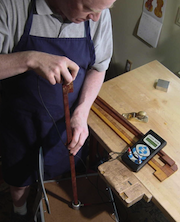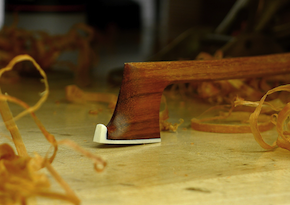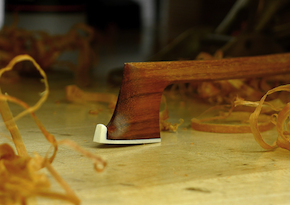
There are perhaps 20 professional bow makers in America. One is John Greenwood, who is the only professional bow maker in the Bay Area and has a shop in San Francisco. We reached him by phone to talk about the basics of bows and what both beginning and advanced students should expect in a fine ‘stick’.
Greenwood majored in music at the University of Iowa but then quickly fell under the spell of ‘practicality’ and became a real-estate developer. At 40, he decided to find a less risky business and thought he might make violins, having a long love of wood as well as music. But then he decided that might be over his head and became a professional bow maker, only to find out that was a master’s craft as well. He learned the craft from the French master, Jean Grunberger.
Greenwood, now 55, makes more than 40 bows a year. It takes 40 to 50 hours to make one. Of the 40 bows, 30 are sold to professionals; the remainder are bought by “promising students and enthusiastic amateurs.”
“I have about 25 bows combined, in the San Francisco Symphony, Opera, and Ballet” orchestras, he said as we began our conversation.
How much does a bow contribute to the sound of an instrument?
I would say, 15 to 20 percent. It’s a significant difference. And it’s remarkable how many people have violins, for example, that have great potential, but they don’t have a bow that’s really the key to bringing out the true tonal qualities.
"It’s remarkable how many people have violins, for example, that have great potential, but they don’t have a bow that’s really the key to bringing out the true tonal qualities." - Bow maker John Greenwood
Are old bows better than new bows?
There’s no benefit to having an old bow per se. It’s all in the bow wood and, of course, the best wood is Pernambuco, which is both unusually stiff and very dense. It also has a real ‘ping’. It comes only from Brazil and has become very scarce because of land clearing practices. Right now, the wood is embargoed, which means that if you are in this business you need to have acquired a substantial supply. I was very lucky in that regard.
Where does the best hair come from?
The hair comes largely from Anping, Mongolia, but also Argentina and Canada. It’s felt that horses from northern climates provide the best quality. White is preferred because the shafts are thinner and not too coarse.
What are the main differences between say a violin bow and a cello bow?

A cello stick is shorter; a bass stick even shorter …
How does one pick a proper bow?
Above all, you are looking for tone, and so you want to know about the wood quality. And also, you’re looking for a chemistry that matches the sum of the parts. You’re looking for playability: Does it feel comfortable in your hand? How fast does it move across the strings, can it keep up with you? Is the balance point correct for you? — this is a matter of proper camber and graduation. Is the thickness right?
How much money should one spend for a bow?
For the beginner, a carbon fiber bow runs for around $500 and gives good quickness and tone. For advanced students, there are now quality bows from both Brazil and China. The wood is very decent. Those sell for between $1,200 and $1,500. (Cello bows generally sell for more than violin or viola bows.)
And then for the professional, the sky is the limit. But in my experience, professionals have begun to understand that the high price of an old bow reflects in part an antique value, beyond its actual worth. So the truth is, you can buy an excellent ‘new’ bow, made with the finest wood, for $4,000 to $5,000.
"Above all, you are looking for tone; want to know about the wood quality. And also you’re looking for a chemistry that matches the sum of the parts." - Greenwood
How do you maintain a bow?
It’s important to always let out the tension after you play. Also make sure to take a bow in to be checked regularly. Like anything else, the parts wear out. For example, in the frog there are little pearl pieces that get worn away. Also, remember that humidity affects the length of the hair, which tends to get short in winter and then longer in summer. I recommend students get rehairs once a year.
Is there a market to resell bows?
I’m not in that business but there are certainly online auction markets. Tarisio is one and in fact I believe they have an auction finishing this week. [That Auction, held in New York, was on October 16 and 17. The day before the auction, there were more than a dozen cello bows, for example, ranging from the high hundreds to $40,000.]
Greenwood’s website is greenwoodbows.com.

